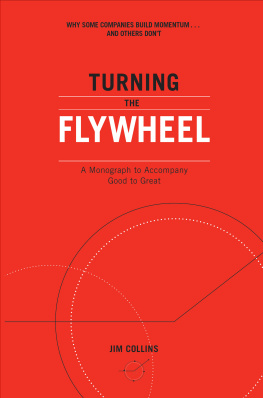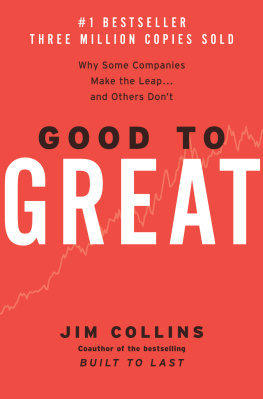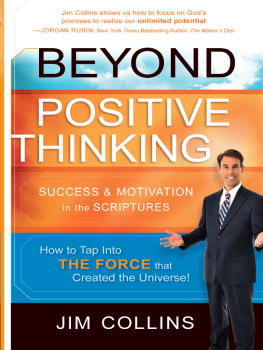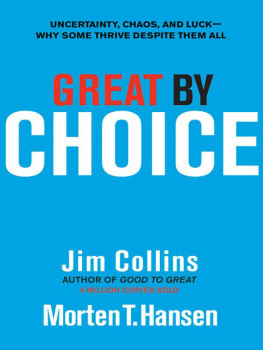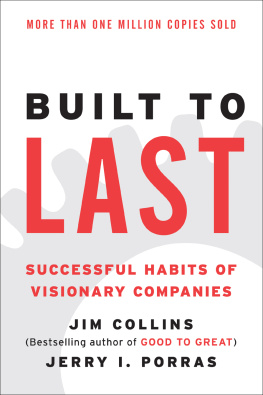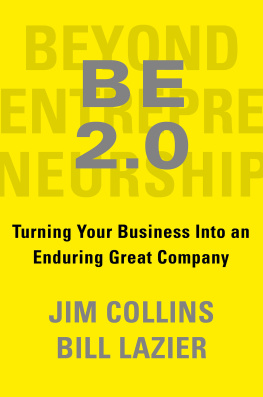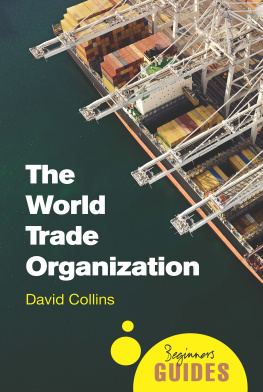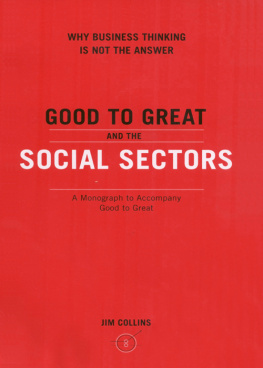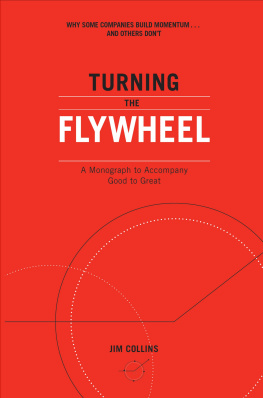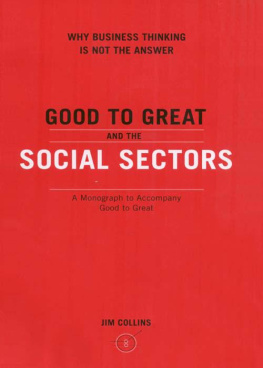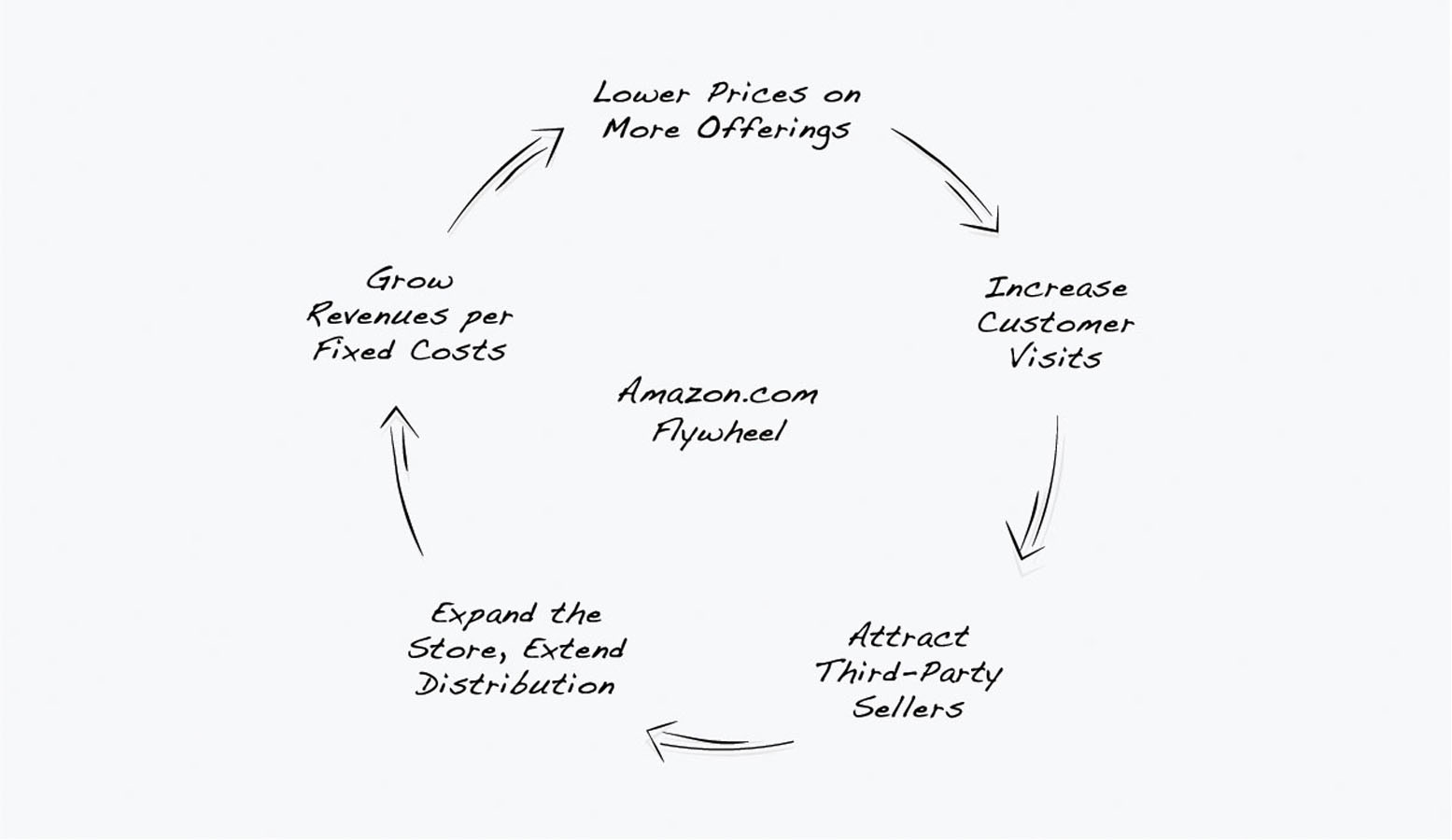Contents
Guide
Australia
HarperCollins Publishers Australia Pty. Ltd.
Level 13, 201 Elizabeth Street
Sydney, NSW 2000, Australia
www.harpercollins.com.au
Canada
HarperCollins Publishers Ltd
Bay Adelaide Centre, East Tower
22 Adelaide Street West, 41st Floor
Toronto, Ontario, Canada
M5H 4E3
www.harpercollins.ca
India
HarperCollins India
A 75, Sector 57
Noida
Uttar Pradesh 201 301
www.harpercollins.co.in
New Zealand
HarperCollins Publishers New Zealand
Unit D1, 63 Apollo Drive
Rosedale 0632
Auckland, New Zealand
www.harpercollins.co.nz
United Kingdom
HarperCollins Publishers Ltd.
1 London Bridge Street
London SE1 9GF, UK
www.harpercollins.co.uk
United States
HarperCollins Publishers Inc.
195 Broadway
New York, NY 10007
www.harpercollins.com
TURNING THE FLYWHEEL . Copyright 2019 by Jim Collins. All rights reserved under International and Pan-American Copyright Conventions. By payment of the required fees, you have been granted the nonexclusive, nontransferable right to access and read the text of this e-book on-screen. No part of this text may be reproduced, transmitted, downloaded, decompiled, reverse-engineered, or stored in or introduced into any information storage and retrieval system, in any form or by any means, whether electronic or mechanical, now known or hereafter invented, without the express written permission of HarperCollins e-books.
Cover design by Element Design Group
FIRST EDITION
Digital Edition FEBRUARY 2019 ISBN: 978-0-06-293380-5
Version 01252019
Print ISBN: 978-0-06-293379-9
To my personal band of brothers you know who you are
in the spirit of loyalty, love, and enduring friendship.
Contents
Beauty does not come from decorative effects but from structural coherence. Pier Luigi Nervi
In the autumn of 2001, just as Good to Great first hit the market, Amazon.com invited me to engage in a spirited dialogue with founder Jeff Bezos and a few members of his executive team. This was right in the middle of the dot-com bust, when some wondered how (or if) Amazon could recover and prevail as a great company. I taught them about the flywheel effect that wed uncovered in our research. In creating a good-to-great transformation, theres no single defining action, no grand program, no single killer innovation, no solitary lucky break, no miracle moment. Rather, it feels like turning a giant, heavy flywheel. Pushing with great effort, you get the flywheel to inch forward. You keep pushing, and with persistent effort, you get the flywheel to complete one entire turn. You dont stop. You keep pushing. The flywheel moves a bit faster. Two turns... then four... then eight... the flywheel builds momentum... sixteen... thirty-two... moving faster... a thousand... ten thousand... a hundred thousand. Then at some pointbreakthrough! The flywheel flies forward with almost unstoppable momentum.
Once you fully grasp how to create flywheel momentum in your particular circumstance (which is the topic of this monograph) and apply that understanding with creativity and discipline, you get the power of strategic compounding. Each turn builds upon previous work as you make a series of good decisions, supremely well executed, that compound one upon another. This is how you build greatness.
The Amazon team grabbed onto the flywheel concept and deployed it to articulate the momentum machine that drove the enterprise at its best. From its inception, Bezos had infused Amazon with an obsession to create ever more value for ever more customers. Its a powerful animating forceperhaps even a noble purposebut the key differentiator lay not just in good intent but in the way Bezos and company turned it into a repeating loop. As Brad Stone later wrote in The Everything Store, Bezos and his lieutenants sketched their own virtuous cycle, which they believed powered their business. It went something like this: Lower prices led to more customer visits. More customers increased the volume of sales and attracted more commission-paying third-party sellers to the site. That allowed Amazon to get more out of fixed costs like the fulfillment centers and the servers needed to run the website. This greater efficiency then enabled it to lower prices further. Feed any part of this flywheel, they reasoned, and it should accelerate the loop. And so, the flywheel would turn, building momentum. Push the flywheel; accelerate momentum. Then repeat. Bezos, Stone continued, considered Amazons application of the flywheel concept the secret sauce.
Ive sketched my own take on the essence of the original Amazon flywheel in the nearby diagram. (Note: Throughout this monograph, Ive included sketches of specific flywheels to illustrate the concept. To be clear, these reflect my own take on the flywheel from each case; the leaders who built these flywheels would likely draw them with more nuance than I have. Use these illustrative sketches to grasp the flywheel concept and to stimulate thinking about your own flywheel.)
Notice the inexorable logic. Trace your way around the Amazon flywheel a few times in your mind, and you can almost get swept up in the momentum. Each component in the flywheel sets you up for the next component, indeed, almost throwing you around the loop.
Bezos and his team could have panicked during the dot-com bust, abandoned the flywheel, and succumbed to what I described in Good to Great as the doom loop. When caught in the doom loop, companies react to disappointing results without disciplinegrasping for a new savior, program, fad, event, or directiononly to experience more disappointment. Then they react without discipline yet again, leading to even more disappointment. Instead, Amazon committed fully to its flywheel and then innovated aggressively within that flywheel to build and accelerate momentum. Amazon not only survived but also became one of the most successful and enduring companies to emerge from the dot-com era. Over time, Amazon would renew and extend the flywheel far beyond a simple e-commerce website and enhance the flywheel with new technology accelerators such as artificial intelligence and machine learning. But throughout, the underlying flywheel architecture remained largely intact, creating a customer-value compounding machine that many of the largest companies in the world came to fear.
Never underestimate the power of a great flywheel, especially when it builds compounding momentum over a very long time. Once you get your flywheel right, you want to renew and extend that flywheel for years to decadesdecision upon decision, action upon action, turn by turneach loop adding to the cumulative effect. But to best accomplish this, you need to understand how your specific flywheel turns. Your flywheel will almost certainly not be identical to Amazons, but it should be just as clear and its logic equally sound.
In the years since publishing Good to Great, Ive challenged dozens of leadership teams to do for themselves what the Amazon team did for itself. Some of those teams traveled to our management lab at the Good to Great Project in Boulder, Colorado, and I watched each team assemble its flywheel, almost like putting together a jigsaw puzzle. Theyd get the pieces laid out and then fiddle with them, arguing and debating, engaged in a disciplined thought process to get their flywheel right. What are the essential components? Which component comes first? What follows? Why? How do we complete the loop? Do we have too many components? Is anything missing? What evidence do we have that this works in practice? Gradually, their specific flywheel would start to emerge. When it all clicked, it felt like the final pieces of the jigsaw puzzle had popped into place. In clarifying their flywheels, these teams experienced the sense of excitement that comes when you seeand

